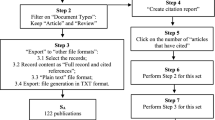Abstract
A change in scientific developments in recent decades is widely proclaimed which may be associated with terms like postmodern science or steady state science. This change is usually discussed from a more epistemological viewpoint. In order to enhance the understanding of the underlying key factors, bibliometric, demographic and Nobel Prize recipient data spanning of the last hundred years are considered and analyzed. It is found that in general the considered data point to a quasi-steady state in bibliometric developments of highly developed countries. For emerging countries, such a steady state is not yet attained; therefore, the research output in scientific journal articles is still expected to rise considerably. Consequences and interpretations of an ever growing research output in relation to the increasing age of Nobel Prize recipients are discussed and conclusions are drawn from the considered data.







Similar content being viewed by others
References
Abraham P. (2000). Duplicate and salami publications. Journal of Postgraduate Medicine, 46, 67–69.
Archibald, G., & Line, M. B. (1991). The size and growth of serial literature 1950–1987. In terms of the number of articles per serial. Scientometrics, 20, 173–196.
Carter, S., Gartner, S., Haines, M. R., Olmstead, A., Sutch, R., & Wright G. (Eds.) (2006). The historical statistics of the United States (Millennial Edn., Vols. 1–6). Cambridge University Press.
Carpenter, M., & Narin, F. (1981). The adequacy of the Science Citation Index (SCI) as an indicator of international scientific activity. Journal of the American Society for Information Science, 32, 430–439.
Cronin, B. (2001). Hyperauthorship: A postmodern perversion or evidence of a structural shift in scholarly communication practices? Journal of the American Society for Information Science and Technology, 52, 558–569.
de Solla Price, D. (1961). Science since Babylon. New Haven: Yale University Press.
de Solla Price, D. (1963). Little science big science. NY: Columbia University Press.
Fernandez-Cano, A., Torralbo, M., & Vallejo, M. (2004). Reconsidering Price’s model of scientific growth: An overview. Scientometrics, 61, 301–321.
Falkenheim, J. C., & Fiegener, M. K. (2007). Records fifth consecutive annual increase in U.S. doctoral awards, 2008. National Science Foundation, Directorate for Social, Behavioral, and Economic Sciences (http://www.nsf.gov/statistics/infbrief/nsf09307/).
Forman, P. (2007). The primacy of science in modernity, of technology in postmodernity, and of ideology in the history of technology. History and Technology, 23, 1–152.
Godin, B. (2006). On the origins of bibliometrics. Scientometrics, 68, 109–133.
Goonatilake, S. (1999). A post-European century in science. Futures, 31, 923–927.
Harvey, D. (1990). The condition of postmodernity. Oxford: Blackwell Publishing.
Heylin, M. (2004). Science is becoming truly worldwide. Chemical and engineering news, 82, 38–42.
Horgan, J. (2004). The end of science revisited. Computer, 37, 37–46.
Karazija, R., & Momkauskaita, A. (2004). The Nobel Prize in physics—regularities and tendencies. Scientometrics, 61, 191–205.
Kölbel, M. (2002). Wachstum der Wissenschaftsressourcen in Deutschland 1650–2000. Berichte zur Wissenschaftsgeschichte, 25, 1–23.
Kuhn, T. S. (1962). The structure of scientific revolutions. Chicago: University of Chicago.
Lariviere, V., Archambault, E., & Gingras, Y. (2008). Long-term variations in the aging of scientific literature. From exponential growth to steady-state science (1900–2004). Journal of the American Society for Information Science and Technology, 59, 288–296.
Leydesdorff, L., & Wagner, C. (2002). Is the United States losing ground in science? A global perspective on the world science system. Scientometrics, 78, 23–36.
Lyotard, J.-F. (1984). The postmodern condition. A report on knowledge. Manchester: Manchester University Press.
Leydesdorff, L., & Zhou, P. (2005). Are the contributions of China and Korea upsetting the world system of science? Scientometrics, 63, 617–630.
National Science Foundation. Science and engineering indicators. (2006). Two volumes, 2006. Arlington, VA. National Science Foundation (volume 1, NSB 06-01; volume 2, NSB 06-01A). Available online at http://www.nsf.gov/statistics/seind06/.
National Science Foundation. Science and engineering indicators. (2008). Two volumes, 2008. Arlington, VA. National Science Foundation (volume 1, NSB 08-01; volume 2, NSB 08-01A). Available online at http://www.nsf.gov/statistics/seind08/.
Phelan, T. J. (1999). A compendium of issues for citation analysis. Scientometrics, 45, 117–136.
Rip, A. (2004). Strategic research, post-modern universities, and research training. Higher Education Policy, 17, 153–166.
Tague, J., Beheshti, J., & Reespotter, L. (1981). The law of exponential-growth—evidence, implications and forecasts. Library Trends, 30, 125–145.
Thurgood, L., Golladay, M. J., & Hill, S. T. (2006). U.S. doctorates in the 20th century, 2006. Special report, National Science Foundation (available at http://www.nsf.gov/statistics/nsf06319/start.cfm).
Vasconcelos, A. M. R., Sorenson, M. M., & Leta, J. (2009). A new input indicator for the assessment of science & technology research? Scientometrics, 80, 219–232.
Zhang, W., & Fuller, R. G. (1998). Nobel Prize winners in physics from 1901 to 1990. Simple statistics for physics teachers. Physics Education, 33, 196–203.
Ziman, J. M. (1994). Prometheus bound—science in a dynamic steady state. Cambridge: Cambridge University Press.
Author information
Authors and Affiliations
Corresponding author
Rights and permissions
About this article
Cite this article
Han, CS., Lee, S.K. & England, M. Transition to postmodern science—related scientometric data. Scientometrics 84, 391–401 (2010). https://doi.org/10.1007/s11192-009-0119-6
Received:
Published:
Issue Date:
DOI: https://doi.org/10.1007/s11192-009-0119-6




